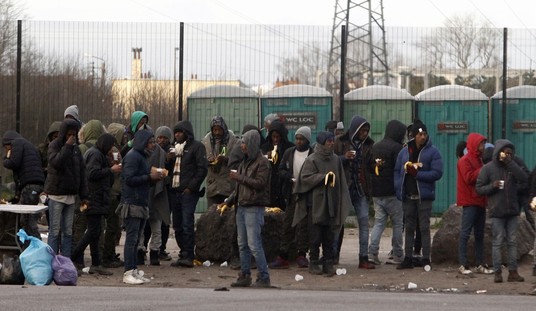Jay Cost thinks so, and it appears that Gallup may have at least tacitly admitted it. The Left has critiqued Gallup’s samples, accusing it of continually oversampling white voters and creating an artificial handicap for Barack Obama’s approval and support numbers. David Axelrod made the loudest noise, but Jay cites a column from Mark Blumenthal at HuffPo as more influential, and it was HuffPo that first noticed the change as well:
Over the summer Mark Blumenthal of Huffington Post wrote a critique of Gallup’s daily presidential job approval poll. The point of which was that Gallup was over-sampling whites and thus understating President Obama’s position in the adult population. I responded by arguing that Blumenthal’s case was underdeveloped and less-than-met-the-eye, and that was basically where things stood.
Until, that is, this week. President Obama enjoyed a bounce in his Gallup job approval number after the Democratic National Convention, as was to be expected, but there was a twist: it did not disappear. And while Gallup on average had found Obama’s job approval around 47 percent with adults through most of 2012, for the last five weeks it has been regularly above 50 percent. Yesterday, it stood at 53 percent, a number we have not really seen since 2009.
Unusual. So, what’s going on? Alan Abramowitz of Huffington Post and The Democratic Strategist noticed that Gallup has increased its share of nonwhites from 27 percent the week of the convention to 32 percent last week, a nearly 20 percent boost. In other words, Gallup seemed to have tweaked its methodology with just weeks to go until Election Day to reflect the criticism that has come from the left.
Gallup pollster Frank Newport acknowledged the change:
As we began this election tracking program on Oct.1, our methodologists also recommended modifying and updating several procedures. We increased the proportion of cell phones in our tracking to 50%, meaning that we now complete interviews with 50% cell phones and 50% landlines each night. This marks a shift from our Gallup Daily tracking, which has previously been 40% cell phones. This means that our weights to various phone targets in the sample can be smaller, given that the actual percentage of cell phones and cell-phone-only respondents in the sample is higher. We have instituted some slight changes in our weighting procedures, including a weight for the density of the population area in which the respondent lives. Although all Gallup surveys are weighted consistently to census targets on demographic parameters, we believe that these improvements provide a more consistent match with weight targets.
The Hill also picked up on the debate:
President Obama’s job approval rating spiked this month, according to Gallup’s daily tracking survey, but the jump may be the result of a shift in the polling outlet’s survey methodology.
Since late 2011, President Obama has held steady at just under 50 percent saying they approved of the job he was doing and just under 50 percent saying they disapproved.
Earlier this month, the trend line moved in favor of the president, and on Thursday it sat at 53 percent positive and 42 negative — a greater job approval rating than Obama enjoyed after the assassination of Osama bin Laden.
However, this movement may have been provoked by a change in the pollster’s methodology, without which the president may have seen no change in job approval.
Pollsters routinely test and adjust their models. After all, the value in polling is their ability to predict voter behavior, and that requires a model of the electorate that closely parallels the actual turnout on a future Election Day. In order to get to the highest level of accuracy, pollsters have to keep analyzing turnout trends and adjust their survey and weighting techniques to match.
However, as Jay points out, it’s unusual for a pollster to make those adjustments just five weeks before the election itself:
What I can say is that it’s problematic to alter one’s methodological approach to polling elections just five weeks before the biggest election in a generation. In fact, I think this is a highly inopportune time to make such a change; do it in the summer of 2012 or the winter of 2013, but for goodness sake not the fall of 2012!
It is even more problematic to make the shift but not spell out in detail the political effect of it. One utility of the Gallup tracker was that it enabled comparisons across time. Those are now difficult to accomplish because we have to assume what effect these methodological shifts have had. My guess is that it has moved the needle toward Obama by maybe 3 points on job approval, but we cannot know for sure. We also have no idea the extent to which this changes the Romney-Obama head-to-head among registered or likely voters.
What Gallup should have done is similar to what the Bureau of Labor Statistics does when it adjusts the unemployment rate to account for new Census data: Give the number as it is now calculated and as it would have been calculated absent the change, so everybody can know exactly what effect the changes in assumptions have had. Newport fails even to acknowledge whether and how this methodological change helped one side over the other, let alone its extent.
I’d raise an eyebrow about the 50% cell-phone respondents as well as the shift in ethnic demographics, and perhaps even more. That would tend to oversample younger voters who are more likely to only have a cell phone, a demo that has a notoriously poor turnout ratio in elections, and probably more city-dwellers than suburban or exurban.
But let’s take a look at the ethnicity demos as compared to the last two big election cycles. In 2008, when Barack Obama reportedly energized and motivated legions of previously-diffident non-white voters, the exit polls showed 74% of the vote to have come from white voters. Two years later in the 2010 midterms, white voters accounted for 77% of the vote — not that far off from each other, when considering the margin of error. That puts the non-white participation group somewhere between 23-26% of the vote.
Of course, Gallup can argue that this only applies to their general-population survey, which is where they derive presidential approval ratings. However, the likely-voter calculations may still be impacted by those general population assumptions, since Gallup isn’t performing separate surveys for their numbers, but are using subsets for RV an LV results. The latest Census Bureau data gives Gallup some support for their general-population adjustment, though. Their 2011 population estimate for the US is 311.6 million people, of which 197.5 million are non-Hispanic whites, which makes 63.3% of the population. Still, the point of political polling — especially this close to the election — is to offer predictive results, and the disparity between previous turnout models and these changes make Gallup less valuable for that purpose, not more so. I’d like to know specifically whether Gallup has made similar adjustments to its RV and LV methodologies — and if so, why.
It seems that Gallup’s original demographic calculation (27%) would come closer to a predictive model for electoral purposes, or perhaps even slightly optimistic for Democrats, considering the enthusiasm difference between 2008 and today. Chuck Todd reported on this very phenomenon in NBC/Marist polling conducted before the first debate:
Let me go to an important voting group for the president, young voters. Look at this engagement level: 52% now they call themselves, voters 18 to 34, call themselves extremely interested in this election. Four years ago it was 72%. That 20 gap. The president wins young voters by huge margins. He’s winning them by some 20-plus points. But if you don’t have this kind of enthusiasm, they’re not going to show up to the polls.
And then let me give you this last one here, because this is, I think, the most important one. And that’s Hispanics. The President’s winning Hispanics by 50 points. He hit the 70% mark. However, look at this in terms of interest in the election. 59% now, it was 77%. What does that mean? President got 65%, I believe, of Hispanics four years ago.
So even though he’s going to get more Hispanics, if less of them turn out, it’s a net zero. And yet, you look at Republican enthusiasm, up, senior enthusiasm, up. It’s a huge problem. And by the way, all of this, pre-debate.
Now, it’s entirely possible that Gallup sees the reverse trend and has adjusted its demographic weighting accordingly. If so, they will have accurate predictions of the turnout and the vote in less than four weeks. However, this kind of enthusiasm tsunami among non-white voters has been entirely missed by every other pollster in the business, none of whom have shown that Obama will turn out non-white voters at a rate that will make them five points larger in the 2012 election than in 2008. And until someone shows data that predicts an 18.5% increase in the ratio of non-white:white voters in 2012 over 2008 (which is what a five-point uptick would be), the impression that this late methodology shift leaves is that Gallup has its thumb on the scales, regardless of their motive for doing so.








Join the conversation as a VIP Member